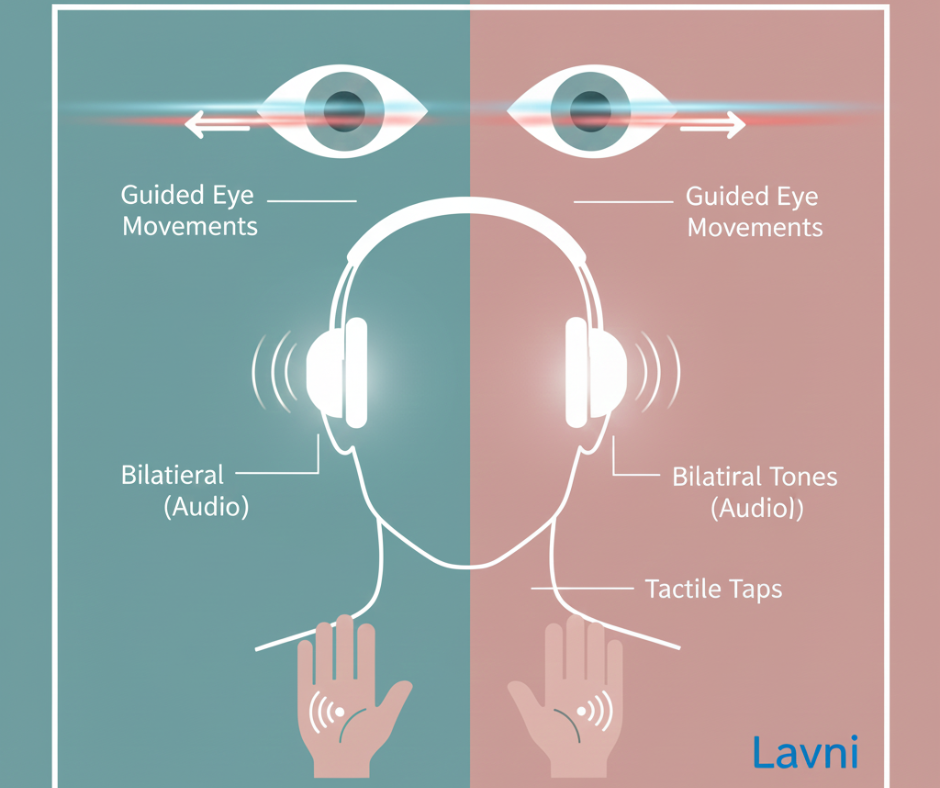EMDR therapy for trauma, covered by Medicaid

Maybe it was a car accident you walked away from, but your body never really did. Maybe it was years of growing up around yelling and slamming doors. Or something you have never said out loud to anyone. You get through your day, but a small part of you is always braced for impact.
A lot of people find Lavni when they are in that place. They hear about EMDR therapy and think, "That sounds like what I need," then run into a wall: no one calls back, the waitlist is months long, or the therapist does not take Medicaid. Our job at Lavni is simple. We help you find EMDR therapists who accept Medicaid or Medicare in North Carolina, Georgia, and Virginia, so you can focus on healing instead of chasing down providers.

EMDR and Medicaid at a glance
Who it is for
People dealing with trauma, PTSD, painful memories, or reactions that feel "too big" for the situation
Where
North Carolina, Georgia, and Virginia, with online and in-person options
What it costs
Many of our Medicaid clients pay between $0 and $3 per session, depending on their plan
How soon
It is often possible to book an appointment in a week or less, sometimes in just a couple of days
If you already know you want EMDR and you have Medicaid, you do not have to read the whole page first. You can find a Medicaid therapist near you and mention EMDR when you fill out the intake form.
What is EMDR therapy, in plain language?
EMDR stands for Eye Movement Desensitization and Reprocessing. That is a long phrase for something simple: helping your brain file away a painful memory so it does not keep hijacking your day.
In an EMDR session, you and your therapist pick a memory, image, or body feeling to work on. While you notice what comes up, your therapist adds gentle left-right stimulation. That might be eye movements, sounds in your headphones going back and forth, or light tapping on your hands or shoulders.

It can sound strange on paper. Many clients describe it like this:
"The memory is still there, but it feels farther away and less sharp. I can think about it without my heart racing."
EMDR is often used for:
If your trauma shows up most in your relationship or marriage, you can also read about relationship and couples counseling with Medicaid .
Does Medicaid cover EMDR therapy?
In many cases, yes. Medicaid usually does not list EMDR by name on the back of your card or on the website. Instead, it talks about "mental health services," "outpatient therapy," or "behavioral health visits." EMDR fits inside those categories when a licensed therapist is using it to treat a real mental health concern like PTSD, anxiety, or depression.
The most important pieces are that your therapist is licensed, enrolled with your Medicaid plan, and documenting your symptoms and progress correctly. The North Carolina, Georgia, and Virginia sections below explain how that usually works in each state. If you are not sure where to start, Lavni can help you check your benefits and match you with someone who knows how to bill your plan.

Does Medicaid cover EMDR therapy in North Carolina?
Short answer: often, yes. North Carolina Medicaid does not always list EMDR by name, but it does cover mental health therapy when it is medically necessary. EMDR is one of the evidence-based tools your therapist may use to treat conditions like PTSD, anxiety, and depression.
Coverage usually depends on three things:
Your therapist is licensed in North Carolina and enrolled with NC Medicaid or your managed care plan.
Your symptoms are documented and meet criteria for a covered condition, such as PTSD, anxiety, or depression.
Your therapist creates a treatment plan and keeps notes that meet Medicaid guidelines.
On Lavni, we only connect you with clinicians who understand how to work with NC Medicaid. Before your first visit, we can help you check your benefits so you have a clear picture of what EMDR sessions are likely to cost with your plan.
What about EMDR coverage in Georgia and Virginia?
Georgia and Virginia also cover therapy through their Medicaid programs. The language on the card or website might be vague, like "outpatient psychotherapy" or "behavioral health visits," but EMDR often fits under that umbrella when a licensed clinician is using it to treat a covered condition.

Here is what that tends to look like in real life:
You have Medicaid in GA or VA and you are dealing with trauma, flashbacks, or strong anxiety.
A licensed therapist who is enrolled with your plan provides EMDR or another trauma-focused therapy.
Visits are billed to Medicaid the same way other therapy sessions would be.
If you are unsure whether your plan will pay for EMDR specifically, you are not alone. Many people are confused at this step. When you register with Lavni, you can upload your insurance information and we can help you check your coverage before you commit to a therapist.
What an EMDR session can actually feel like

Many EMDR sessions happen online now, as long as you have a private space and a stable connection.
Every therapist does EMDR a little differently, but here is the kind of story we hear a lot.
One of our clients in Raleigh (we will call her "Jasmine," not her real name) came to EMDR after a car accident. Months later she still avoided driving, jumped at every horn, and felt sick in parking lots. In her first few sessions, she and her therapist did not dive straight into the accident. They worked on breathing, grounding, and finding a "calm place" she could picture in her mind.
When Jasmine was ready, they started brief sets of EMDR focused on an image from the day of the accident. Her therapist would ask, "What are you noticing now?" after each set. Sometimes the answer was "my chest feels tight," sometimes it was a random memory that popped up, sometimes it was "nothing, just tired."
Over a handful of weeks, she noticed that the accident memory felt less like it was happening right now and more like it belonged in the past. She still remembers it. She just does not relive it every time she gets in a car.
Your story will be different, but the shape is similar. EMDR sessions often include:
A check-in and grounding so you are not jumping straight into the deep end.
Choosing a target (memory, image, or sensation) to focus on that day.
Short sets of eye movements, sounds, or taps while you notice what comes up.
Pauses to talk about what you are feeling and decide whether to keep going.
Ending with calming exercises so you can go back to your day without feeling flooded.
You stay in control. You can tell your therapist to slow down or stop at any point.
Who EMDR can help (and when it might not be the first step)
EMDR is not only for people with "big T" trauma. It can help if you:
Keep replaying the same event or conversation in your head, even years later.
Snap at people you care about for reasons that do not fully make sense to you.
Feel your heart race or your stomach drop when you see certain places, people, or colors.
Feel numb most of the time, then suddenly overwhelmed by emotion.
If you are looking for support for a teenager who has been through something difficult, you can also read about therapy for teens and kids .
⚠️ When EMDR might wait:
Sometimes EMDR is not the very first step. If you are not safe, dealing with active substance use, or struggling to get through the day, a good therapist will start with stabilization and coping skills first. EMDR can come later, when your foundation feels a little steadier.
How Lavni fits into your EMDR journey with Medicaid
Many of the people who end up on Lavni have tried the usual route already. They call three or four offices. One never calls back. One says they are "not taking new Medicaid clients." One gives them an appointment three months out. It is exhausting, and for a lot of folks, it is easier to give up than keep dialing.

Lavni was built for people who rely on Medicaid and Medicare, not as an afterthought. We:
Work with therapists who are credentialed with Medicaid and Medicare in your state.
Highlight clinicians who offer EMDR or other trauma-focused therapies.
Help check your benefits before you commit to ongoing sessions.
Handle claims and billing in the background so you do not have to argue with insurance.
So far, more than 2,000 people with Medicaid have used Lavni to find a therapist. Some of them choose EMDR. Others find different approaches that fit them better. Either way, our job is to make sure insurance is a bridge, not a barrier.
Questions people often ask about EMDR and Medicaid
How much does EMDR cost with Medicaid?
It depends on your plan, but many of our clients with Medicaid pay somewhere between $0 and $3 per session. There is no subscription fee to use Lavni. Before you get deep into EMDR, we help you check your coverage so you know what to expect.
Can I do EMDR online with Medicaid?
In a lot of cases, yes. Many Medicaid plans now cover video sessions the same way they cover in-person visits. As long as you are in the same state where your therapist is licensed and they are enrolled with your plan, online EMDR can often be billed just like a regular therapy session. Many people do EMDR from their bedroom, living room, or even parked car, as long as the space feels private.
How do I find an EMDR therapist who actually takes Medicaid?
You could call around and ask every office if they take your plan and offer EMDR. Or you could let us do that work. When you join Lavni, you tell us:
- Your state and Medicaid or Medicare plan.
- That trauma or painful memories are a main reason you are seeking help.
- Whether you prefer online or in-person sessions.
We match you with therapists who meet those criteria, and you can see Medicaid therapists near you who have openings.
What if my Medicaid plan will not list EMDR by name?
That is common. Most cards and websites do not say "EMDR." They say things like "outpatient therapy" or "mental health services." The important part is that a licensed therapist is treating a covered condition and documenting your care. Your therapist can use EMDR inside that visit, the same way they might use talk therapy or cognitive behavioral therapy, as long as it fits your needs and your plan's rules.
Take the next small step toward EMDR therapy
If part of you is curious about EMDR and part of you is scared to start, that is normal. You do not have to decide everything today. You can start with one small step: finding out what your Medicaid plan will cover and who is available to help.
If you have Medicaid in North Carolina, Georgia, or Virginia and you want to explore EMDR, Lavni can help you find a therapist who understands both trauma and the realities of using insurance.
Fill out a short form, tell us a bit about what you are going through, and we will help you see what your options look like before you commit.
